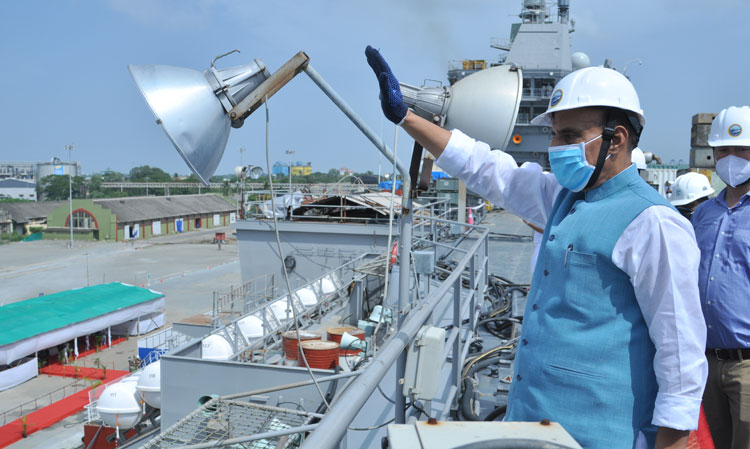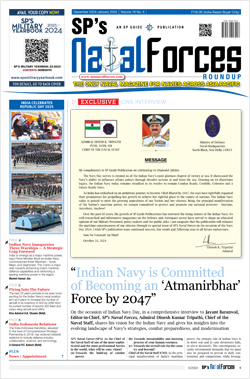INDIAN ARMED FORCES CHIEFS ON OUR RELENTLESS AND FOCUSED PUBLISHING EFFORTS

The insightful articles, inspiring narrations and analytical perspectives presented by the Editorial Team, establish an alluring connect with the reader. My compliments and best wishes to SP Guide Publications.

"Over the past 60 years, the growth of SP Guide Publications has mirrored the rising stature of Indian Navy. Its well-researched and informative magazines on Defence and Aerospace sector have served to shape an educated opinion of our military personnel, policy makers and the public alike. I wish SP's Publication team continued success, fair winds and following seas in all future endeavour!"

Since, its inception in 1964, SP Guide Publications has consistently demonstrated commitment to high-quality journalism in the aerospace and defence sectors, earning a well-deserved reputation as Asia's largest media house in this domain. I wish SP Guide Publications continued success in its pursuit of excellence.
- MoD initiates comprehensive review of Defence Acquisition Procedure 2020, pushes for defence reforms
- G7: The Swansong
- Kalinga Connect: South Asia to Polynesia
- Advanced MRSAM for India for a greater firepower
- Must Credit DRDO for Operation Sindoor, now what is next for defence R&D?
- Operation Sindoor | Day 2 DGMOs Briefing
- Operation Sindoor: Resolute yet Restrained
India’s first indigenous aircraft carrier to be commissioned in 2022
From design to steel used in construction to key weapons and sensors, IAC has nearly 75 per cent indigenous content.

Country’s first Indigenous Aircraft Carrier is on its way to be commissioned next year. Defence Minister Rajnath Singh reviewed the progress of construction of the carrier at Cochin Shipyard on June 25, 2021. Being lauded as the most potent sea-based asset, Indigenous Aircraft Carrier (IAC) will be commissioned as INS Vikrant in the first half of 2022. Acknowledging the “significant progress” made on the construction of IAC-1, despite COVID-19 restrictions, Singh stated that the commissioning of the carrier will be a befitting tribute to 75 years of India's independence.
IAC would offer an incomparable military instrument with its ability to project airpower over long distances, including air interdiction, anti-surface warfare, offensive and defensive counter-air, airborne anti-submarine warfare and airborne early warning, stated the official press release.
Reviewed first-hand the ongoing work on the Indigenous Aircraft Carrier, which is India's pride and a shining example of Atmanirbhar Bharat. The IAC has made significant progress.
— Rajnath Singh (@rajnathsingh) June 25, 2021
Commissioning of the IAC next year will be a befitting tribute to 75 years of India's independence. pic.twitter.com/N9542pJneq
The Defence Minister said, “IAC has nearly 75 per cent indigenous content - from design to steel used in construction to key weapons and sensors. It is a shining example of ‘AtmaNirbhar Bharat’ envisioned by Prime Minister Narendra Modi. Given the combat capability, reach and versatility of the aircraft carrier, it will add formidable capabilities in the defence of the country and help secure India's interests in maritime domain.” He recalled a recent approval accorded by the Defence Acquisition Council for Request for Proposal (RFP) of Project 75-I submarines under the Strategic Partnership model, which will give further fillip to indigenous development of niche manufacturing technologies.
IAC would offer an incomparable military instrument with its ability to project air power over long distances, including air interdiction, anti-surface warfare, offensive and defensive counter-air, airborne anti-submarine warfare and airborne early warning.
During the visit to the construction site, Singh was accompanied by Chief of the Naval Staff, Admiral Karambir Singh and Flag Officer Commanding-in-Chief, Southern Naval Command, Vice Admiral AK Chawla.
Raksha Mantri Shri @rajnathsingh addressing the officers and sailors of Indian Navy after reviewing the progress of construction of first Indigenous Aircraft Carrier at Kochi on June 25, 2021. Also seen is Chief of the Naval Staff Admiral Karambir Singh. pic.twitter.com/zRRNdCiNqY
— A. Bharat Bhushan Babu (@SpokespersonMoD) June 25, 2021
IAC Journey
- The ship shall be operating the MiG-29K fighter aircraft, Kamov-31 air early warning helicopters, the soon to be inducted MH-60R multi-role helicopter and the indigenously manufactured Advanced Light Helicopters (ALH).
- Earlier scheduled to be commissioned in 2018, the plans for the ship were sailed in 1989, while the design work only started ten years later in 1999.
- The keel was placed another decade later, while the ship was floated out of its dry dock in 2011 and launched in August 2013.
- The basin trials for IAC have been completed in November 2020.
- The first sea trials of the aircraft carrier are expected this year as early as next month and the commissioning into the Eastern Naval Command is planned next year as INS Vikrant (India's first aircraft carrier which was decommissioned in 1997).
- Designed by the Indian Navy’s Directorate of Naval Design (DND), IAC is 262 metres long and 62 metres wide. It has the capacity to launch 30 aircraft, including 20 fighter jets and 10 helicopters. The ship will have two runways and a landing strip with STOBAR (short take off but arrested delivery) equipment.
- IAC has progressed on integration of several other navigational, communication and operational systems since then, as it prepares for its maiden Contractor Sea Trials (CST).
Project Seabird
Before reaching Kochi, the Defence Minister had also visited the Karwar Naval Base on June 24, 2021 and reviewed the progress of the ongoing infrastructure development under ‘Project Seabird’ which involves creation of a naval base at Karwar on the west coast of India.
?? Project ?? ???? ???? ?? ???, ????? ??????? ????????? ????, ????? trade, economy, ?? ?????? ?????? ???????? ??? ?? ???? ??????? ????, ??? ???? ??????? ??: ????? ??????
— ????? ?????? ????????/ RMO India (@DefenceMinIndia) June 24, 2021
The Defence Minister reaffirmed the Government’s commitment towards a strong Indian Navy, underlining his confidence that after the completion of this project, the Karwar Naval Base would become Asia's largest and most efficient naval base. “The completion of this project will not only aid our security preparedness but also trade, economy and humanitarian missions. I was also informed that in this project, nation's first sealift facility has been created,” he added.
“It is a shining example of ‘AtmaNirbhar Bharat’ envisioned by Prime Minister Narendra Modi. Given the combat capability, reach and versatility of the aircraft carrier, it will add formidable capabilities in the defence of the country and help secure India's interests in maritime domain,” said the Defence Minister.
An aerial survey of various ongoing projects being conducted at INS Kadamba under the Navy’s “Project Seabird” was done by the Minister. Additionally on-site briefings were provided to him, including capability demonstration at the ship lift tower, a tour of the naval harbour and review of the marine works/ infrastructure being developed as part of “Project Seabird” Phase IIA.
Visited Karwar Naval Base today to review the progress of ongoing infrastructure development under ‘Project Seabird’. I am confident that after the completion of this project, the Karwar Naval Base would become Asia's largest and most efficient Naval base. pic.twitter.com/8z6QcST4QM
— Rajnath Singh (@rajnathsingh) June 24, 2021
The project, christened INS Kadamba in 2005, witnessed the completion of its first phase in 2005 while the second phase was initiated in 2011. The project is significant to the country’s naval future as well as the blue economy that India is tapping into.
The Government of India, Ministry of Defence had acquired private land measuring 2412 acres 15 guntas 7 anas located in 13 vilages of Talukas Karwar and Ankola, Uttar Kannada District in Karnataka for the purpose of creating this Naval Base.
Naval Innovation & Indigenisation
The Minister appreciated Indian Navy’s commitment to “AtmaNirbhar Bharat”, mentioning that of the 48 ships and submarines that are presently being inducted into the Navy, 46 are of indigenous construction and adding the utilisation of “more than two-thirds of the Navy’s modernisation budget on indigenous procurement” as part of the government’s efforts to boost self-reliance in the Indian Navy.
The ship shall be operating the MiG-29K fighter aircraft, Kamov-31 air early warning helicopters, the MH-60R multi-role helicopter and the indigenously manufactured Advanced Light Helicopters (ALH).
The government had taken several initiatives to promote self-reliance in defence manufacturing, he added. Some of the initiatives highlighted by him include allocation of 64 per cent of modernisation funds under the capital acquisition budget for 2021-22 for domestic procurement, changes in the Defence Acquisition Procedure 2020 and an increase in the foreign direct investment limit in private companies in the defence sector to 74 per cent.
The Defence Minister underlined his confidence that after the completion of this project, the Karwar Naval Base would become Asia's largest and most efficient naval base.
“IAC and Project Seabird at Karwar, are the examples of our unwavering focus. An emphasis on indigenisation will enhance the Navy's operational reach and prowess and I assure all possible support to the Navy for bolstering their operational preparedness as a strong Naval force is crucial for peace, security and prosperity,” stated the Minister.
Navy and Pandemic
As part of his two-day visit to the Southern Naval Command, Singh also went to some of the training establishments under Southern Naval Command and appreciated the efforts of the Indian Navy for continuously providing professional training not only to the officers and sailors of Indian Navy but also to friendly foreign Navies even amidst the COVID-19 pandemic.
????? ??? ?? ?? oxygen ?? ???? ?? ????? ???? ????, ????? ?? ?????? ?? ??????? ????? ??? oxygen supplies, containers ?? ???? ??????? ?? ???? ??? ???? ?????? ????? ??: ????? ?????? ???? @rajnathsingh
— ????? ?????? ????????/ RMO India (@DefenceMinIndia) June 24, 2021
The Minister applauded Indian Navy for its contribution in the fight against the pandemic - from bringing back Indian citizens from overseas during Operation SamudraSetu I and ferrying in Liquid Medical Oxygen from abroad during Operation SamudraSetu lI - despite the danger of spread of the virus on board warships.
????? maritime ?? National security ???, @indiannavy ?? ?? ?????? ??? ??, ???? ???? ??? ????? ??? ???? ???? ?? ??? 1961 ?? ???? ?????? ????? ??, 1971 ?? ????-??? ????? ??, ?????? ?? ?? ??? ?? ???? ????? ?? ???? ?? ????? ???? ??? ?? ?????? ?? ??? ??? ???? ???? ?????? ????? ??:RM
— ????? ?????? ????????/ RMO India (@DefenceMinIndia) June 24, 2021
An exhibition showcasing Indian Navy's various ongoing innovations, indigenisation and operations aligning with the nation's fight against the pandemic was also organised for the Defence Minister. Most exhibits were the ones which had provided affordable, effective and user-friendly medical solutions, highlighted the official statement. The major ones included:
- The Oxygen Recycling System (ORS), which is currently under clinical trials at Sree Chitra Tirunal Institute for Medical Science and Technology
- Navrakshak PPE and masks currently being used in PM CARES Hospitals
- Remote Patient Monitoring System
????? ?????? ??? ???? ??? ?? ??? ???? ??? ????? ???, ???? capacity ?? capability ??? ?? ???? ????????? ??, ???? services ?? ??? ???? coordination ?? jointness ????, ???? ??? ????? ?? ??? ?? ???? ????? ??? ???: ???? @rajnathsingh
— ????? ?????? ????????/ RMO India (@DefenceMinIndia) June 24, 2021
Speaking on the Galwan incident, Singh said, “Indian Navy's proactive forward deployment signalled that the country wants peace but is ready for any eventuality. Indian Navy remains poised and combat ready to tackle any challenge.” He reiterated the Prime Minister's vision of SAGAR (Security and Growth for All in the Region) and the wider goal of a free, open and inclusive Indo-Pacific to ensure peace and stability in the region and at the same time commended the Search and Rescue (SAR) efforts by Navy during Cyclone Tauktae and Cyclone Yaas.





